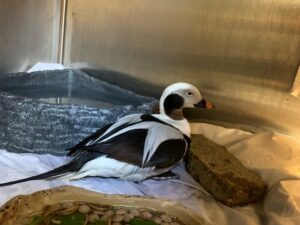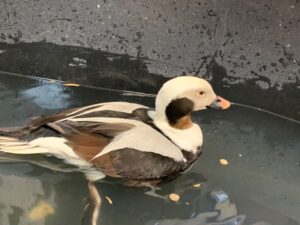 Meet patient 23-12, the long-tailed duck, a beautiful species of sea duck known for their unique vocalizations and coloration. The first one to ever be admitted to our Wildlife Clinic, this handsome adult male was unable to fly and bleeding from his chest, warranting immediate help from our rehabilitators.
Meet patient 23-12, the long-tailed duck, a beautiful species of sea duck known for their unique vocalizations and coloration. The first one to ever be admitted to our Wildlife Clinic, this handsome adult male was unable to fly and bleeding from his chest, warranting immediate help from our rehabilitators.
Our intake examination revealed a wound below the neck that was scabbed over and already beginning the healing process. We also noticed a bit of cloudiness in his left eye, determined to be light trauma. After performing some x-rays, we were able to rule out any fractures or other internal injury. Based on the location of the injuries, we believe that the poor duck either collided with a telephone wire or a window while flying above the city.

 Long-tailed ducks are excellent swimmers and divers and have been recorded at depths of over 150 feet in the ocean. They are typically found in the waters of the Arctic and spend the winter on the open ocean, hunting for small crustaceans and fish, though they also eat aquatic plants. They are a rare sight to see in Pennsylvania, so the question is… what is one doing in Philadelphia?
Long-tailed ducks are excellent swimmers and divers and have been recorded at depths of over 150 feet in the ocean. They are typically found in the waters of the Arctic and spend the winter on the open ocean, hunting for small crustaceans and fish, though they also eat aquatic plants. They are a rare sight to see in Pennsylvania, so the question is… what is one doing in Philadelphia?
There have been a few recent sightings of a flock of long-tailed ducks in South Philly who have likely traveled inland for more feeding opportunities. It is not uncommon to see these ducks along the New Jersey coastline, so it’s possible they flew over from there.
Because this species is so uncommon in Philly, a lot of research went into creating proper meals and an ideal enclosure to fit his needs. We relied on our colleagues at Tri-State Bird Rescue & Research in Newark, Delaware, who have experience with this species. They guided us through everything this special duck would need and we are so grateful for their help!
We gave the long-tailed duck pain medication and a topical steroid for his eye, and we made sure he got plenty of swimming time every day so that he could exercise and bathe—long-tailed ducks spend most of their time in water, so that is where he is happiest.
He eventually recovered well and we were able to successfully release him back into the wild. Before returning to the wild, each animal must pass a pre-release assessment. We want to ensure that each patient returns home with the highest likelihood of success. In the case of the long-tailed duck, we made sure his injuries were healed and that he was able to fly, swim, and dive for food.
Long-tailed ducks migrate in a pattern opposite from what we usually see: they travel north in the winter and south in the summer. We had to release him somewhere that has been confirmed to be on their migration route. Using the National Audubon Society app, we researched recent sightings of long-tailed ducks near where he was rescued and selected the perfect location for this handsome duck to be released. Once he gains his bearings, he will begin his migration journey again and hopefully catch up with his flock.


THANK YOU FOR THAT ARTICLE. FIRST TIME I HEARD OF THAT SPECIES AND IT WAS VERY INTERESTING.
Thank you for caring for this very special duck – he’s beautiful. Have never heard of this breed before, but have heard of the unfortunate thing of birds flying into high rise windows. Praying all goes well with his recovery.
Thank you for all you do to help the local and visiting wildlife who are in need. And also for taking the time to share the information and photos with us.
A beautiful creature – many thanks for sharing this story, for your care of wildlife, and for the couple who took the time to bring him to the clinic. He needs a name – how about… Chester?
I JUST LEARNED A LOT ABOUT A DUCK I DIDNOT KNOW EXISITED. THIS ARTICLE WAS VERY INTERING AND INFORMATIVE. AND THANK YOU (THE SCHUYKILL WILD LIFE CENTER) FOR CARING AND SAVING OUR WILDLIFE. WHERE WOULD WE BE WITHOUT YOU!